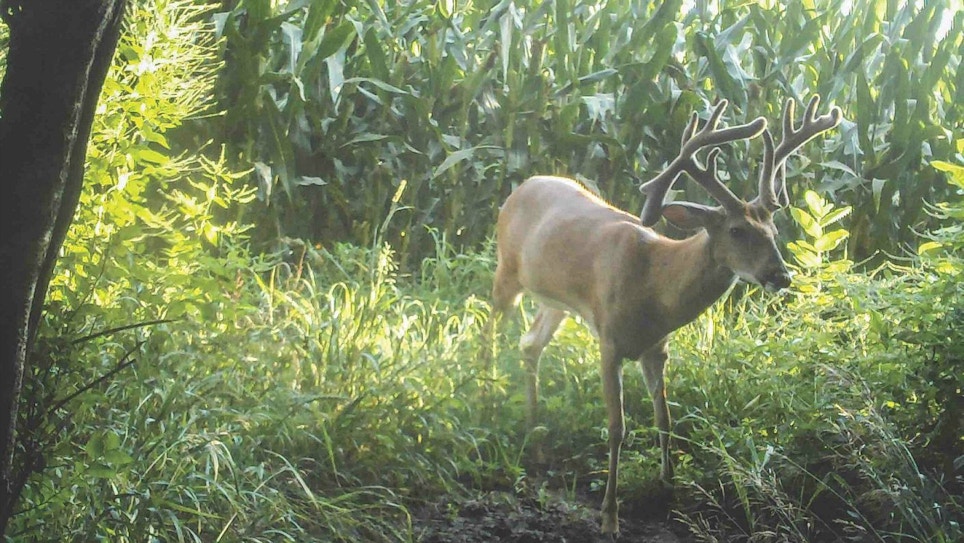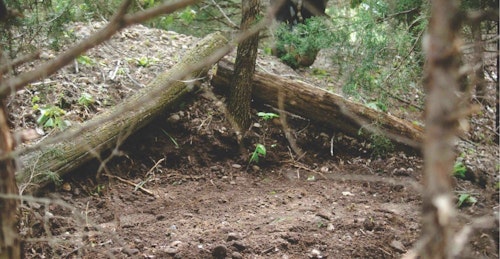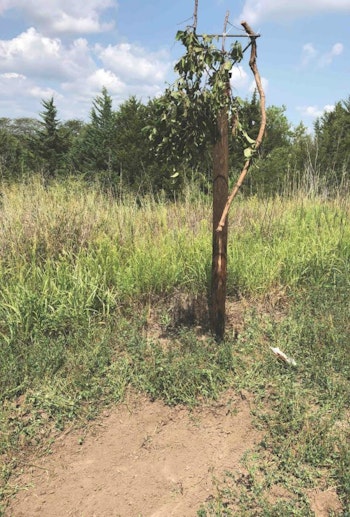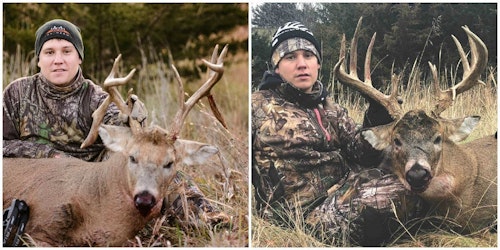
This eight-year-old double drop-tine buck posed for a picture early in the summer more than 4 miles from the Bauer farm.
There’s a strong chance you’ve never heard the name Terron Bauer, and that’s just fine with him. You see, Terron isn’t a Facebook chest-thumper or working tirelessly to become an Instastar. That’s just not who he is. Terron is happiest when the world is quiet — when social media is far from him — when he’s hidden somewhere in the midst of his family’s 260-acre farm.
Truthfully, all that matters to Terron are his family, his friends and his deer. He is a whitetail Yoda, and his 2018 Nebraska archery season was nothing short of spectacular.
It’s Worth It
“Up until the 2017 season, it had been four years since I’d shot a buck with my bow,” Bauer told me. “In 2017, I shot a beautiful 160-inch buck, but up to that point, I’d totally taken my foot off the gas.
“It was funny. Lots of people simply thought I wasn’t killing deer because of mismanagement. Others thought I just wasn’t a closer. It was humorous to me. I didn’t care. I had a plan, and I was going to stick with it. I was tired of shooting three and a half-year-old deer.”
Let me echo Terron’s words: He really doesn’t care what others think. Oh, and how far off all of the naysayers were. You see Terron is one of my best friends, and during his four-year drought he was sending me pictures of the bucks he was passing. I told him he was crazy. Some of them were just so impressive.
“It was tough,” he said. “I don’t know how many bucks I passed during that four-year stint, but it was a bunch. We just didn’t have many mature deer on the property, especially after the EHD die-off. We had lots of up and comers but not loads of mature deer.
“I started to notice, as my management plan improved, I was getting more mature deer on the property. My patience and dedication to management was paying off. In 2017, I killed that 160-inch buck, and then last season I shot an ancient eight-year-old with double drop tines, as well as a gorgeous 150-plus inch buck.”
The Double Drop
“I didn’t have any history with this buck, really,” Bauer said. “A buddy had sent me some trail camera pictures of the buck earlier in the summer (top photo). He was 4 miles away, and I figured I’d never lay eyes on him. He was a cool buck. He had double drops and my buddy told me he had sustained a shoulder injury at some point.”
It’s important to point out that Terron Bauer is the mayor of south-central Nebraska; at least that’s what I call him. It drives him nuts. From July through December his phone is constantly buzzing. Most of the time it’s guys wanting advice about food plots, hinge cutting, creating buck beds and the like. Other times, it’s buddies sending him pictures of random deer. The bottom line: If a buck is killed anywhere in a 20-mile radius around his hunting area, he knows about it immediately.
“It was November 4, and I was sitting in an elevated ground blind, overlooking a small alfalfa kill plot I’d put in,” Bauer said. “I’d gotten in early that afternoon, and honestly didn’t think I was going to see anything for a while, but shortly after getting settled, I peeked out the window and the buck was standing on the edge of the plot. I immediately noticed the double-drop tines. My mind shot back to that summer photo. There was no doubt it was the buck. He hobbled a bit on his front. I was thinking about shooting him at 45 yards, but I’d forgot my rangefinder. I let him walk. Two hours later, I caught a glimpse of him. He eased back onto the plot on a travel corridor I’d put in before season. The travel corridor funneled him right to the plot, and he immediately went to work over the mock scrape. I shot him at 14 yards. When I stood up to look down on the plot and check things out, my No. 1 hit list buck was standing in the plot looking up at me. It was a crazy day.”
Another One Bites the Dust
“I’d stayed out of the area for 3 full days, and even though fickle winds were predicted, I chose to go back in on November 8,” Bauer said. “The rut was rocking, and the temperature and pressure were perfect. My elevated ground blind, in combination with my Ozonics unit, allowed me to remain undetected in this area most of the time.
“I would have liked to have hunted another stand, but the wind just wasn’t right, and frankly, there was only one other buck I was interested in shooting, and that was the buck that was looking up at me in the blind window on November 4.
“It was just awesome. It was meant to be. The buck I went in to hunt was the first deer on the plot. He was very cautious and looked up at the blind window several times. Slowly, he made his way to my mock scrape, and then turned around and looked back toward the blind. With the wind all over the place, I left my windows closed. I wasn’t about to open one until he was preoccupied with the scrape. That didn’t happen. He started to stick his nose toward the licking branch and then turned and walked straight at me. He disappeared underneath the blind.
“About an hour later, a doe popped out on the plot and he was right behind her. The power of the rut saved me. He never even glanced at the blind, leading to his demise.”
The Bauer Way
This story isn’t just about two big Midwest bucks that hit the dirt. The real story is Bauer’s dedication to management — how tirelessly he works to make his 100 huntable acres of timber and 160-acres of agriculture the best they can be.
“I don’t have enough ground — enough timber — to hold deer,” Bauer said. “Sure, I will hold a few, but my main goal is to go completely low impact. Lots of guys talk about having a sanctuary; a place on the property they don’t hunt. I believe your entire property should be a sanctuary.
“I work really hard to have everything done by the time the leaves come on the trees. I have my kill plots in, my mock scrapes set, hinge-cuts done and the buck beds finished. All of my stands and blinds are ready to go. Entrance and exit trails are trimmed and my cameras are up.
“Having all of these things done really cuts down on the amount of time spent in the woods during the summer and early fall. I want to get everything ready and then go out of sight and out of mind. Lots of people will tell you it doesn’t matter if you bump deer during the summer. I just don’t take that chance. My property is too small, and the less I’m in the area the better.
“This spring I really went the extra mile and mowed and sprayed trails leading to and from bedding areas. I groomed the trails and made them easy to travel. The deer are loving it. It’s taking the time to do little things like this — putting in the work ahead of time — that will help you reap big results.
“I hinge-cut trees to promote better doe bedding. Basically, hinge-cutting is cutting a tree at an angle about half-way through and then letting it fall without cutting it all the way through. This allows the tree to continue to leaf out and provides adequate bedding cover for does.
“When it comes to bucks, I like to build buck beds. Bucks like to use topography and prefer to bed on slight rises in heavy cover. I seek out these areas and improve or create new buck beds by cutting entrance and escape routes. I also level the ground and add some logs for them to lean against. It’s an awesome system and gives you the advantage of knowing where a buck or two may be bedded. After the season, I often go check the beds and they are full of white belly hair, and the cedars and other trees around them are shredded. It works so well.
“When it comes to food, I like to give the deer options. I want grains for the late season and a good mix of various proteins for the early season. Small kill plots tucked into the timber — plots deer can hit on their way to the big agricultural fields — work amazingly well. And now that I have manicured trails leading from these kill plots to bedding areas, the action should only improve.”


“Another big part of my system, and one that anyone can do, is utilizing mock scrapes,” Bauer said. “Yes, there are plenty of trees for deer to scrape on, but I want my scrape situated within shooting distance of my stand. My method is take a pressure-treated cedar post, dig a sizeable hole and then burry and tamp in the post. Next, I cut a couple of long, straight limbs and attach them to the upper portion of the post. You can attach them in lots of ways. You can drill holes and slide them through or use a u-shaped nail. Personally, I have my dad weld brackets that I attach to the post. These brackets hold the branches really well and allow the branches to hang straight down. I’ve found the bucks like downward hanging licking branches better than those that run straight out and are broken off at the end. I will slip back into the area in July and apply a little buck forehead gland, but other than that, I stay out once the mock scrapes are in.
“In addition to the forehead gland, I add a mock scrape. I don’t apply scent. The fresh dirt is enough, and by the time I go in and hunt, these scrapes grow significantly in size over time. It’s a great way to get a buck inventory, and a great way to get a passer-by buck to stop long enough for a shot.”

I’m a big believer in Bauer’s mock scrape system. I’ve followed suit on my properties, and the results have been incredible. Not to mention the fact that last season while hunting a lease just a few miles from Bauer’s property, my target buck came in and worked my mock scrape, rubbed the licking branch and tattered the cedar post. He walked away minutes before legal light, but came back an hour later on the heels of a hot doe and my arrow found its mark.
“Another thing, and I don’t want guys and gals to think I’m telling them not to hunt, but man, you gotta hunt smart,” Bauer said. “If you’re hunting public dirt or have access to private property that other bowhunters are also hunting, my advice would be different. Yes, still hunt smart, but you may have to press the envelope a little. Nothing affects deer behavior negatively like hunting pressure. Always ask yourself if it makes sense to be in the woods. I also feel that by staying out and only striking when the time is right allows you the ability to hunt calm deer. Case in point, my target buck saw me in the blind three days before I killed him this past season. Three days later I killed him in the same spot.”
Food for thought from a true whitetail whisperer. Apply his advice and your little property will produce big rewards.






